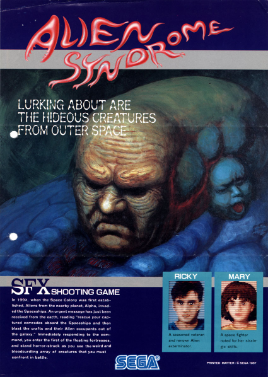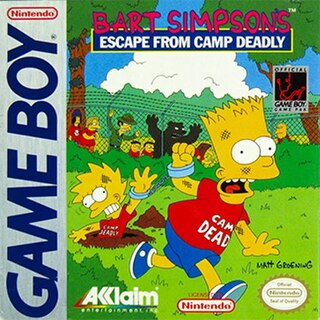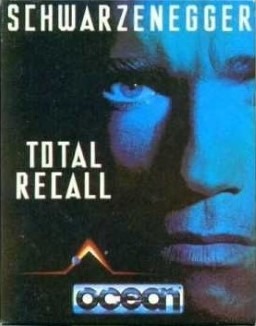
Alien Syndrome is a run and gun video game developed by Sega and released in arcades in 1987, and later ported to the Master System in 1988. The game utilizes a side-scrolling feature that allows the player to take control of either a male (Ricky) or female (Mary) soldier whilst hunting aliens and saving hostages before they run out of time.

Paperboy is an arcade action game developed and published by Atari Games, and released in 1985. The player takes the role of a paperboy who delivers a fictional newspaper called The Daily Sun along a street on his bicycle. The arcade version of the game featured bike handlebars as the controller.

Krome Studios Melbourne, originally Beam Software, was an Australian video game development studio founded in 1980 by Alfred Milgrom and Naomi Besen and based in Melbourne, Australia. Initially formed to produce books and software to be published by Melbourne House, a company they had established in London in 1977, the studio operated independently from 1987 until 1999, when it was acquired by Infogrames, who changed the name to Infogrames Melbourne House Pty Ltd.. In 2006 the studio was sold to Krome Studios.

Smash TV is a 1990 arcade video game created by Eugene Jarvis and Mark Turmell for Williams Electronics Games. It is a twin-stick shooter in the same vein as 1982's Robotron: 2084, which was also co-created by Jarvis. The Super Nintendo Entertainment System, Genesis, Master System, and Game Gear versions are titled Super Smash TV.

Turrican is a 1990 video game developed by Manfred Trenz. It was developed for the Commodore 64 by Rainbow Arts, and was ported to other systems later. In addition to concept design and character creation, Trenz programmed Turrican on the Commodore 64. A sequel, Turrican II: The Final Fight, followed in 1991 for the Commodore 64 and other platforms.

The Simpsons: Bart vs. the World is a side-scrolling platform game based on the Simpsons franchise and features many aspects from the television series. It was released in 1991 for the Nintendo Entertainment System, and in 1993 for Amiga, Atari ST, Game Gear, and Master System. In the game, the player controls Bart as he travels around the world on a scavenger hunt while facing against Mr. Burns' family and agents. The game has received mixed reviews from critics.

Bart Simpson's Escape from Camp Deadly is a 1991 platform video game for the Game Boy. Developed by Imagineering, it was published by Acclaim Entertainment in North America and Europe in 1991. The game was released in Japan in 1993. In Bart Simpson's Escape from Camp Deadly, the player controls Bart from the television series The Simpsons as he escapes from an unpleasant summer camp run by ruthless counselors. The plot is similar to that of The Simpsons episode "Kamp Krusty", although the game was released nearly a year before that episode aired. Critics gave the game mixed to negative reviews.

Krusty's Fun House is a puzzle video game based on the animated sitcom The Simpsons.

The Simpsons: Bartman Meets Radioactive Man is a 1992 platform game published by Acclaim for the Nintendo Entertainment System and Game Gear. Developed by Imagineering, the side-scrolling game features Bart Simpson on a comic book quest to rescue his kidnapped idol, superhero Radioactive Man. Bartman Meets Radioactive Man received generally negative reviews from critics, with criticism being directed at the gameplay control.
Imagineering, based in Glen Rock, New Jersey, was an American in-house studio of Absolute Entertainment. Many notable video games developed for Absolute include A Boy and His Blob: Trouble on Blobolonia, Battle Tank, Super Battletank and The Rescue of Princess Blobette. They are also best known for their video games developed for third-party publishers, such as Acclaim Entertainment, Atari Corporation, Activision, Hi Tech Expressions, Gametek and THQ.

RoboCop 2 is a platform shooter video game based on the 1990 film of the same name. The game was released for several platforms, including Amiga, Amstrad GX4000, Atari ST, Commodore 64, Game Boy, Nintendo Entertainment System, and ZX Spectrum. Ocean Software developed and published several versions, and Data East manufactured an arcade version.

RoboCop 3 is a video game based on the 1993 film of the same name. Amiga, Atari ST and DOS versions were developed by Digital Image Design beginning in September 1990, and published by Ocean Software in December 1991. The Digital Image Design version includes multiple gameplay styles. During 1992 and 1993, other versions consisting of side-scrolling platform gameplay were released for the Commodore 64, ZX Spectrum, NES, Super NES, Game Gear, Master System, and Sega Genesis.

Cybernoid: The Fighting Machine is a shoot 'em up developed and published in 1988 by Hewson Consultants for the ZX Spectrum. It was ported to the Amstrad CPC, Atari ST, Commodore 64, Amiga, and Nintendo Entertainment System. It was programmed by Raffaele Cecco. The ZX Spectrum, Amstrad, and Atari ST versions have a main theme by Dave Rogers, while the Commodore C64 version has a different theme by Jeroen Tel.

Garry Kitchen is a video game designer, programmer, and executive best known for his work at Activision during the early years of the company's history. He has developed games for the Atari 2600, Commodore 64, Nintendo Entertainment System, and Super Nintendo Entertainment System, as well as co-founded Absolute Entertainment with ex-Activision developers. His port of Donkey Kong for the Atari 2600 was a major hit for Coleco, selling over 4 million copies. His other 2600 work includes Keystone Kapers and Pressure Cooker for Activision and Space Jockey for U.S. Games. He also wrote Garry Kitchen's GameMaker and The Designer's Pencil for the Commodore 64.

Total Recall is a 1990 platform game developed and published by Ocean Software that was released for the Commodore 64, Amiga, Amstrad CPC, ZX Spectrum, Atari ST, and Nintendo Entertainment System. Total Recall is based on the 1990 film of the same name.

CJ's Elephant Antics is a platform game developed by Genesis for the Commodore 64 with conversions made for the Amiga, Atari ST, ZX Spectrum and Nintendo Entertainment System. All ports were handled by Genesis with the exception of the ZX Spectrum version which was handled by Big Red Software. The computer versions were published by Codemasters in 1991, with the NES game arriving in 1992 as part of the unlicensed compilation cartridge Quattro Arcade. The player controls a baby elephant by the name of Columbus Jumbo on his way home to Africa.

Space Gun is a 1990 first-person shooter arcade game released by Taito. The game is set aboard a crippled space station that has been overrun by hostile alien creatures. The objective is to rescue human crew members while destroying the alien creatures. The game lets the player shoot limbs off the creatures, resulting in blood splatters.
















